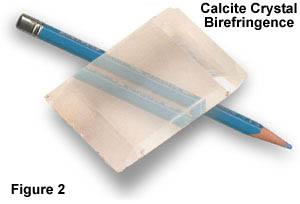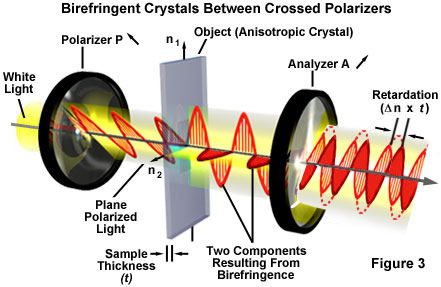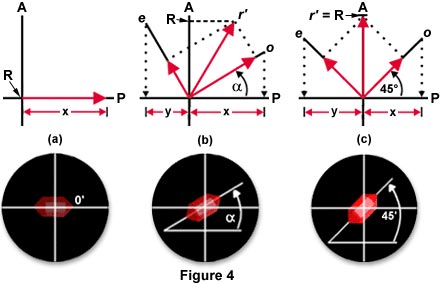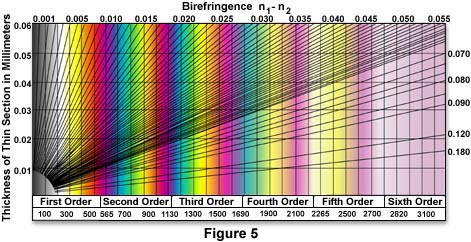Many transparent solids are optically isotropic, meaning that the index of refraction is equal in all directions throughout the crystalline lattice. Examples of isotropic solids are glass, table salt (sodium chloride, illustrated in Figure 1(a)), many polymers, and a wide variety of both organic and inorganic compounds.

The simplest crystalline lattice structure is cubic, as illustrated by the molecular model of sodium chloride in Figure 1(a), in which all of the sodium and chloride ions are arranged with uniform spacing along three mutually perpendicular axes. Each chloride ion is surrounded by (and electrostatically bonded to) six individual sodium ions and visa versa for the sodium ions. The lattice structure illustrated in Figure 1(b) represents the mineral calcite (calcium carbonate), which consists of calcium and carbonate ions. Calcite has an anisotropic crystalline lattice that interacts with light in a totally different manner than isotropic crystals. The polymer illustrated in Figure 1(c) is amorphous and devoid of any recognizable crystalline structure. Polymers often possess some degree of crystalline order and may or may not be optically transparent.
Crystals are classified as being either isotropic or anisotropic depending upon their optical behavior and whether or not their crystallographic axes are equivalent. All isotropic crystals have equivalent axes that interact with light in a similar manner, regardless of the crystal orientation with respect to incident light waves. Light entering an isotropic crystal is refracted at a constant angle and passes through the crystal at a single velocity without being polarized by interaction with the electronic components of the crystalline lattice.
Double Refraction
Explore how birefringent crystals, such as calcite (Iceland spar), refract light into two rays that are separated by a wide margin.
Anisotropic crystals, on the other hand, have crystallographically distinct axes and interact with light in a manner that is dependent upon the orientation of the crystalline lattice with respect to the incident light. When light enters the optical axis of anisotropic crystals, it acts in a manner similar to interaction with isotropic crystals and passes through at a single velocity. However, when light enters a non-equivalent axis, it is refracted into two rays each polarized with the vibration directions oriented at right angles to one another, and traveling at different velocities. This phenomenon is termed "double" or "bi" refraction and is seen to a greater or lesser degree in all anisotropic crystals.

Perhaps the most dramatic demonstration of double refraction occurs with calcium carbonate (calcite) crystals as illustrated in Figure 2. The rhombohedral cleavage block of calcite in Figure 2 produces two images when it is placed over the blue pencil. One of the images appears as you normally would expect when viewing an object through clear glass or an isotropic crystal. The other pencil image appears displaced, due to the nature of doubly-refracted light. When anisotropic crystals refract light, the resulting rays are polarized and travel at different velocities as discussed above. One of the rays travels with the same velocity in every direction through the crystal and is termed the ordinary ray. The other ray travels with a velocity that is dependent upon the propagation direction within the crystal. This light ray is termed the extraordinary ray. The distance of separation between the ordinary and extraordinary ray increases with increasing crystal thickness. The two independent refractive indices of anisotropic crystals are quantified in terms of their birefringence, a measure of the difference in refractive index. Thus, the birefringence (B, often termed δ, or Δ) of a crystal is defined as:
where nhigh is the largest refractive index and nlow is the smallest. This expression holds true for any part or fragment of an anisotropic crystal with the exception of light waves propagated along the optical axis of the crystal. As we mentioned above, light that is doubly refracted through anisotropic crystals is polarized with the vibration directions of the polarized ordinary and extraordinary light waves being oriented perpendicular to each other. We can now examine how anisotropic crystals behave under polarized illumination in a polarizing microscope. Figure 3 illustrates a birefringent crystal placed between two polarizers whose vibration directions are perpendicular to each other (and oriented according to the arrows next to the polarizer and analyzer labels).

White light entering the polarizer on the left is polarized with an orientation in the direction indicated by the arrow (next to the polarizer label) and is arbitrarily represented by a "red" sinusoidal light wave. Next, the polarized light enters the anisotropic crystal where it is refracted and divided into two separate components vibrating parallel to the crystallographic axes and perpendicular to each other (arbitrarily, the "blue" and "red" light waves). The polarized light waves then pass through the analyzer (whose polarization position is indicated by the arrow next to the analyzer label), which passes only those components of the light waves that are parallel to the polarization direction of the analyzer. The retardation of one ray with respect to another is indicated by Δn × t, the difference in speed between the ordinary and extraordinary rays refracted by the anisotropic crystal.
Let us now examine more closely how birefringent anisotropic crystals interact with polarized light in an optical microscope. Our subject material is a hypothetical tetragonal crystal having an optical axis oriented parallel to the long axis of the crystal. Light entering the crystal from the polarizer will be traveling perpendicular to the optical (long) axis of the crystal. Figure 4 illustrates the crystal as it would appear in the eyepieces of a microscope under crossed-polarized illumination. In each part of Figure 4, the axis of the microscope polarizer is indicated by a P and is oriented in an East-West direction. The axis of the microscope analyzer is indicated by an A and is oriented in a North-South direction. These axes are perpendicular to each other and result in a totally dark field when viewed through the eyepieces without insertion of birefringent crystals. Figure 4(a) illustrates an anisotropic birefringent crystal that has the long (optical) axis oriented parallel to the direction of the polarizer.

In this case, light passing through the polarizer, and subsequently through the crystal, is vibrating in a plane that is parallel to the direction of the polarizer. There is no contribution from light passing through the analyzer (because of the single direction of light vibration -- parallel to the polarizer) resulting in the crystal being very dark and almost invisible. In Figure 4(a) the crystal is not totally extinct (as it would be between crossed polarizers) but passes a small portion of red light. This was done for illustration purposes only to allow visitors to note the position of the crystal.
Microscopists classically refer to this orientation as being a position of extinction for the crystal. This observation is important in determining the refractive indices of anisotropic materials with a polarizing microscope. By removing the analyzer in a crossed polarizing microscope, the single permitted direction of vibration of light passing through the polarizer interacts with only one electrical component in the birefringent material (crystal). This allows segregation of a single refractive index for measurement. The remaining refractive index of the material can then be measured by rotation of the polarizer by 90 degrees.
Birefringent Crystals in Polarized Light
Explore how birefringent anisotropic crystals interact with polarized light in an optical microscope as the circular stage is rotated through 360 degrees.
Start Tutorial »The situation is very different in Figure 4(b), where the long (optical) axis of the crystal is now positioned at an angle (α) with respect to the polarizer. In this case a portion of the light received through the polarizer is passed on to the analyzer. To quantitate the amount of light passing through the analyzer, we can apply simple vector analysis to solve the problem. The first step is to find the contributions from the polarizer to o and e (see Figure 4(b)---these are arbitrary designations for the ordinary (o) ray and extraordinary (e) ray similar to the method described by Foster). This is accomplished by dropping projections of the vectors onto the axis of the polarizer. This method assumes the arbitrary value of 1 for both o and e, which are proportional to the actual intensities of the ordinary and extraordinary ray. The contributions from the polarizer for o and e are illustrated with red arrows designated by x and y on the polarizer axis (P) in Figure 4(b). These lengths are then measured on the vectors o and e (also shown as red arrows on the vectors) to produce the resultant r', which is projected onto the analyzer axis (A) as the absolute value R. As we discussed above, the value of R on the analyzer axis is proportional to the amount of light passing through the analyzer. This indicates that some light from the polarizer passes through the analyzer and the birefringent crystal displays some order of brightness.
Polarized Light Microscopy
Examine how a birefringent specimen behaves between crossed polarizers in a microscope.
The maximum brightness for a the birefringent material is shown when the long (optical) axis of the crystal is oriented at a 45 degree angle to both the polarizer and analyzer, as illustrated in Figure 4(c). Dropping the projections of the vectors o and e onto the polarizer axis (P) determines the contributions of the polarizer to these vectors. When these projections are then measured on the vectors (again with red arrows on the vectors) and completing the rectangle to compute the resultant value r', we find the maximum possible contribution to light passed through to the analyzer in this system. This method will work for the orientation of any crystal with respect to the polarizer and analyzer axis because o and e are always at right angles to each other, with the only difference being the orientation of o and e with respect to the crystal axes.
To examine this phenomenon further, we invite you to visit our interactive Java tutorial that explores the amount of light passing through a birefringent crystal when it is rotated between the polarizer and analyzer in a polarizing microscope. Please use the links in the Java text box for navigation to this tutorial.
Now we will consider the phase relationship and velocity differences between the ordinary and extraordinary rays after they pass through a birefringent crystal. These rays are oriented so that they are vibrating at right angles to each other. Each ray will encounter a slightly different electrical environment (refractive index) as it enters the crystal and this will affect the velocity at which ray passes through the crystal. Because of the difference in refractive indices, one ray will pass through the crystal at a slower rate than the other ray. In other words, the velocity of the slower ray will be retarded with respect to the faster ray. This retardation can be quantified using the following equation:
or
Γ = t × |nhigh - nlow|
Where Γ is the quantitative retardation of the material, t is the thickness of the birefringent crystal (or material) and B is birefringence as defined above. Factors contributing to the value of retardation are the magnitude of the difference in refractive indices for the environments seen by the ordinary and extraordinary rays and also the sample thickness. Obviously, the greater the difference in either refractive indices or thickness, the greater the degree of retardation. Early observations made on the mineral calcite indicated that thicker calcite crystals caused greater differences in splitting of the images seen through the crystals illustrated in Figure 2. This agrees with the equation above that states retardation will increase with crystal (or sample) thickness.
When the ordinary and extraordinary rays emerge from the birefringent crystal, they are still vibrating at right angles with respect to one another. However, the components of these waves that pass through the analyzer are vibrating in the same plane as illustrated in Figure 3 above. Because one wave is retarded with respect to the other, interference (either constructive or destructive) occurs between the waves as they pass through the analyzer. The net result is that some birefringent samples acquire a spectrum of color when observed in white light through crossed polarizers. This will be discussed in greater detail in the section on Polarized Light Microscopy.
Quantitation of the colors seen in birefringent samples is commonly provided by means of the Michel-Levy chart illustrated in Figure 5 above. As is evident from this graph, the polarization colors seen in the microscope can be correlated with the actual retardation, thickness, and birefringence of the sample. The chart is simple to use with birefringent samples if you know two of the three variables. When the sample is placed between crossed polarizers in the microscope and rotated to a position of maximum brightness, the color produced by the sample can be traced down on the retardation axis to find the wavelength difference between the ordinary and extraordinary ray of the sample. Alternatively, by measuring the refractive indices of the sample and calculating their difference (the birefringence (B), you can find the color of the sample from the birefringence values along the top of the chart. By extrapolating the angled lines back to the ordinate, you can also calculate the thickness of the sample.
Retardation Polarized Light Microscopy
Examine how a birefringent specimen behaves in a microscope with a retardation plate.
The bottom section of the Michel-Levy chart marks the orders of retardation in multiples of approximately 550 nanometers. The area between zero and 550 nanometers is known as the first order of the polarization colors, and the magenta color that occurs in the 550 nanometer region is often called first-order red. Colors between 550 and 1100 nanometers are termed second-order colors and so on up the chart. The black color at the beginning of the chart is called zero-order black. Most Michel-Levy charts plot higher-order colors up to the fifth or sixth order.
The most sensitive area of the chart is first-order red (550 nanometers), because even a slight change in retardation causes the color to shift dramatically either up to cyan or down to yellow. Many microscope manufacturers take advantage of this sensitivity by providing a full-wave retardation plate or first-order red compensator with their polarizing microscopes to assist scientists in determining the properties of birefringent materials.
